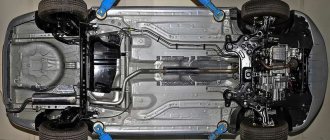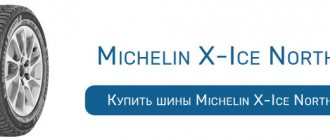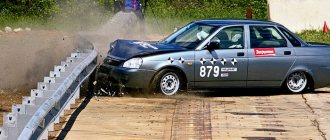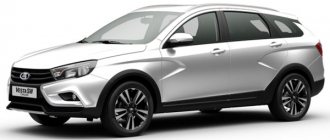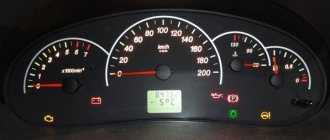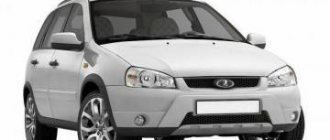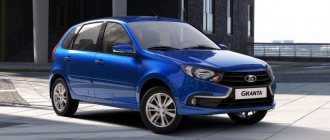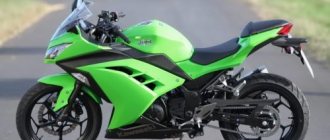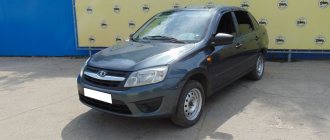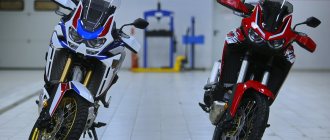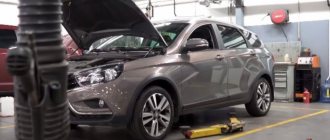Representatives of AvtoVAZ, who arrived for our Vesta crash test, respectfully called this gray-haired German “Doctor” - as is customary in Germany to address people with an academic degree. Before moving to Tolyatti in February last year, the Doctor held a high position in the development department of a very serious German concern. And, probably, his obligations to this company implied a “non-disclosure agreement” even after the end of the contract. Otherwise, why would the VAZ people insist that we not mention the Doctor’s name and not publish photographs? So let’s just call him Doctor X. The task before him was not an easy one: to bring Vesta’s passive safety to three stars in the Euro NCAP rating and to four “our” ARCAP stars. Happened?
- Ernst Glas? Of course I know him,” Doctor X was not embarrassed by my question.
Let me remind you that it was Ernst Glas who was sent from Wolfsburg to our crash test of the Volkswagen Polo (AR No. 23, 2010). The German sedan then earned 14.3 points out of 16 possible and the maximum four ARCAP stars - the best result in the entire history of Autoreview crash tests.
We purchased our Vesta before the New Year - and not in Moscow, but in Perm, in order to nip all speculation about special training in the bud. True, we had to deviate from our rules and buy a car for 570 thousand rubles in the Comfort configuration with two airbags: the basic Classic versions with one driver’s airbag were simply not on sale at that time. But while we were asking the engineers how to correctly disable the passenger airbag, VAZ decided that the “basic” Vesta would also have two airbags.
What was the real reason? The desire of buyers, as the VAZ directorate claims, market conditions (this is the version of the PR department) - or did Tolyatti decide at all costs to get a high result in our ARCAP rating? After all, the cheat sheet for sellers sent to dealers in November indicated that Vesta with one pillow scores three ARCAP stars, and with two, four.
Regardless of the motives, the step is worthy of praise: the car has a priori become safer.
And this is just one of the mini-detectives related to the passive safety of the new VAZ model.
Another example. Ten years ago, the very first prototype of Project C (many developments on it formed the basis of Vesta) immediately scored 13 points out of 16 possible for a frontal strike according to the Euro NCAP method (AR No. 12, 2006). And a year ago, some VAZ workers answered the question “How’s Vesta?” They answered: “No way. Recently they hit it and it fell apart. The bosses said they wouldn’t let Vesta and I work, they would take us to Spain.”
Maybe that’s also why these engineers no longer work at VAZ?
The official version says that the body was calculated using mathematical models, and in the power structure, “five new grades of high-strength steel were finally used.” In addition to Tolyatti, work on the rigidity of the cabin “cage” and the energy-absorbing properties of the side members was carried out at the research centers IDIADA (Spain) and UTAC (France). Abroad, by the way, all the work on the “soft” hood and front bumper was completed: VAZ still does not have its own installation for checking the safety of pedestrians. And the pillows and pyro-tensioning belts were calibrated by Takata. It is the company that currently supplies restraint systems for all VAZ models. The Swedish Autoliv is being considered as an alternative: in Togliatti, the scandal with the spontaneous deployment of Takata airbags, which ended last year with a record recall for the United States of 34 million cars of Japanese, American and European brands, was not ignored.
The stakes on Vesta are high, and with the fall of the ruble it has only increased: the economic salvation of the project must be sought in external, including European, markets. That’s why Doctor X was invited to VAZ. And that’s why dozens of prototypes were destroyed - several times more than during the development of Grants (AR No. 18, 2012). For the same reason, the VAZ delegation was so representative: three engineers checked the landing of the dummies before the impact. By the way, the aforementioned Ernst Glass recommended putting the back of the seat more vertical in the Polo sedan and raising the upper seat belt fastenings to the extreme position. But Dr. X did not bother to optimize the fit: the belts remained installed in the middle position - and the standard 25° backrest tilt from the vertical.
We carried out a crash test at 64 km/h with a 40% overlap at the NAMI test site near Dmitrov. Firstly, with the current euro exchange rate it is cheaper than abroad. And secondly, the testing laboratory has been significantly modernized in recent years. To accelerate the car, a new electric motor is now used, which does not require a long wait for the flywheel system to spin up and allows it to more accurately maintain a given speed - it is now controlled by a modern optical system. In addition to the pair of Hybrid III mannequins, another one, the latest modification, was purchased. And the problem with the thermal dependence of sensors, primarily calibrated fins (their deformation is correct only at temperatures of 19-22 ° C), at 16 degrees below zero outside, was solved with the help of heat guns and gas heaters installed at the starting position at the beginning of the covered but unheated acceleration stripes.
Pre-production testing of LadaVestaCrossSport
Even before serial production of cars started, comprehensive testing began. It was the month of May 2021. One of these tests was attended by analysts from Autoreview, an authoritative publication trusted in the automotive world. Then the car was tested during a side impact on a ram weighing nine hundred kilograms, there was also a removable tip, and the speed was 50 km/h.
The test vehicle was the most fully equipped car, which contained four airbags. The result exceeded all expectations, and the AVTOVAZ designers were proud of it. Most of the impact energy was absorbed by the threshold, the performance of the side airbags fully met expectations, and the rear windows were not damaged in principle, which cannot be said about the driver's window.
AVTOVAZ reports say that the sensors attached to the driver’s dummy did not detect excessive load. According to HIC (hydrogen induced cracking) standards, which indicate head trauma, a good result was obtained. One Autoreview expert noted an interesting feature. The manufacturer did not test the Cross station wagon version with the luggage compartment loaded, although such a test would seem necessary. Such a test would show how securely the oversized luggage located above the window line is fixed. AVTOVAZ explained why they decided not to conduct such a crash test on the Lada Vesta Cross sw. The reason lies in the very purpose of the car, because it is not designed to transport goods, but is an SUV that has increased cross-country ability, but nothing more.
Active and passive safety
During a crash test, the passive and active safety of the vehicle is checked.
Active Safety Features
Active safety is the design and operational characteristics of a vehicle that are used to prevent the risk of accidents on the road. These properties include:
- The anti-lock braking system prevents locked wheels from slipping and the vehicle from skidding. Thanks to this system, the braking distance is significantly shorter, in an emergency braking situation the driver does not lose control, sharp turns by the steering wheel are eliminated, and panic occurs less frequently. Any modern car in basic configurations is equipped with an ABS system. The system can be supplemented with traction control, directional stability and emergency braking assistance.
- Anti-slip system. Prevents loss of wheel traction with the road surface, preventing slipping of the drive axle wheels in wet road conditions during rain or snow.
- Stability control system. The system helps stabilize the course when dangerous situations arise that involve loss of steering control. Electronic stability control is one of the most effective active safety features available today.
- Distribution of braking forces. An auxiliary system that complements the ABS. A distinctive feature is the ability to constantly monitor the control of the braking system. The adhesion of the wheels to the road surface is uneven, and the braking force that is transmitted to the mechanisms is always the same. The system helps control stability during braking by assessing the level of traction on each wheel and distributing braking force across the wheels to apply even braking to each wheel. The likelihood of skidding and losing the trajectory of movement is sharply reduced, braking on a turn becomes less dangerous, especially during icy conditions.
In addition to the described active security systems, there are many additional ones:
- parking assistants (these are various parking sensors, rear view cameras with markings and ultrasonic sensors that warn of dangerous proximity to an obstacle on the way through a sound signal);
- cruise control (helps maintain a certain speed of the car, decreasing or increasing it when decreasing or increasing);
- assistants on ascents and descents.
Well, the most famous and long-standing assistant is the handbrake, which holds the car, fixing the rear wheels with a strong locking braking system. Helps you park in parking lots, including those on a slope.
Passive safety
In addition to active safety, the car also has passive safety. These are certain properties of the technical equipment and design of the car, created to reduce the consequences of an accident. These elements include:
- airbags;
- seat belts;
- head restraints (in the event of a collision, they prevent the risk of fracture of the cervical vertebrae);
- front and rear body elements that absorb impact energy (bumpers);
- soft front panel that wrinkles without harm to the driver and passengers;
- foldable steering column;
- the pedal assembly, if it is injury-proof, upon impact is separated from the mounts without damaging the legs;
- glass that shatters into small fragments with non-sharp edges;
- displacement of the engine and other large components during a collision downwards under the bottom - this prevents them from getting into the cabin.
Passive safety serves to reduce the risk of death or serious physical injury in an emergency. Passive safety also includes the size of the body frame. In the event of a collision, the parts should not be greatly deformed. Therefore, the structure and integrity of the body are carefully tested at the factory, only after which mass production is launched. Lada Vesta was developed taking into account the necessary requirements for passive and active safety.
Crash test Lada Vesta SV cross – production version
As soon as sales of the car started, station wagons, which were classified as production models, were tested. To assess the consequences of a frontal impact, the ARCAP method (frontal collision with an obstacle at a speed of 64 km/h) was used, and the test was carried out by representatives of the Autoreview publication. A test of the consequences of a side impact was carried out on a specially equipped territory of the AVTOVAZ plant. Repeated full-cycle tests were necessary, since both the ground clearance and weight of the production car had increased.
Financial expenses
Using an official service, we can calculate the cost of car repairs:
- repair + restoration: 40,000 rubles;
- parts + spare parts: 70,000 rub.
Thus, we get approximately 110,000 thousand rubles. – and this despite the fact that we will be asked to wait 30 days for the missing parts.
A typical auto repair shop will offer prices approximately as follows:
- repair + restoration: 40,000 rubles;
- parts + spare parts: 20,000 rub.
In total, about 60,000 rubles accumulate.
Here's the thing. The official service decided that only the front fender on the left side could be repaired. Other deformed elements only need to be replaced. Accordingly, they would have to be purchased from the same service (beam, bumper trim, and headlight; other parts could be restored).
Drawing a parallel with the financial costs of such restoration for foreign cars, we get what is shown below:
As it is easy to summarize, if your Vesta has outlived the warranty period, restoring it in regular auto repair shops will cost significantly less than repairing cars from foreign manufacturers.
Vesta Cross frontal impact test
Representatives of “Autoreview” purchased a car specifically for testing for 798,000 rubles, which ended up being badly damaged. To assess the consequences, it was necessary to organize a frontal collision with deformable ceilings, speed – km/h. Even before the start of the procedure, specialists noted the presence of large wheels, which is a clear advantage of the car. The top version of the Cross station wagon is equipped with 17-inch wheels, but the sedan can only boast 15-inch wheels. Experts measured the mass of the car, it turned out that it weighs 148 kg more than the sedan, so energy absorption was expected to be 13% more.
Specialists from the manufacturer’s plant were also invited for testing. The first impression after the collision was that the car withstood it perfectly. Due to the additional amplifiers, there was no displacement of the front pillar, and excellent performance of the left spar was noted - it turned out to be folded, and this made it possible to absorb a significant part of the impact energy. One of the alloy wheels cracked from the energy, but also took part of the impact. The excellent work of ERA-GLONASS is noted; almost instantly after the collision, a company employee got in touch. There was virtually no effort required to open the driver's door, and the airbag deployment was also excellent. The table shows what damage the mannequins in the front row received:
| Head and cervical injuries | None. Norm. When the car bounced off during the collision, the driver's head turned, but without any damage to his health. |
| Knee injuries | A slight impact of the right knee on the dashboard, no contact of the left knee with the plastic is noted |
| Damage to the chest compartment | None. The seat belts worked well, the compression force was assessed as normal. During the collision, the steering wheel moved away from the person by thirty millimeters |
| Foot injuries | None. The pedal assembly has moved slightly, but there is no danger to health. |
According to the results of this testing, the car is resistant to frontal impact and received a high score. However, if you test a car according to the progressive European methodology Euro NCAP, the result is not so good, since it is also necessary to evaluate the structural integrity of the passenger seat in the cabin. After removing the decorative plastic that covers the area of the sills and wings, a number of creases in the metal of the rear and front sills are clearly visible. It is known that since 2016, the plant has modified the front sills in cars using thicker metals. Representatives of Autoreview decided to cut the threshold and remove the external linings - as it turned out, the deformation also affected the power unit itself.
After that, we decided to start removing the floor sound insulation, under which a torn floor appeared, that is, the legroom was destroyed, and this is already a reason to deduct one point. The ruptures occurred exactly at the points, but there were no complaints about the welding. Consequently, the sheet metal supplied to AVTOVAZ is not of sufficient quality. The floor of the car under the driver's seat was also deformed, it was raised, and this was an excessive load on the shin area. As a result, the crash test of the Lada Vesta SV Cross actually failed - it earned only a satisfactory rating. The maximum score was 16 points, and Vesta got only 11.7. Minuses were received for the following reasons:
- The lower legs are not sufficiently protected.
- The floor is deformed, according to Euro NCAP standards, this indicates that the doorway is not stable.
- The threshold broke and the dummy hit the plastic steering column. Although it is not dangerous, the plastic covers a number of metal components.
The car was given only three stars.
AvtoVAZ's arguments
According to information received from AvtoVAZ, the Lada Vesta was fully tested for safety. Moreover, the tests were carried out according to the criteria of Euro NCAP, UNECE and ARCAP. According to plant workers, first there was a stage of virtual testing (about 150 tests), as a result of which the most vulnerable segments of Vesta were identified. After this, real tests began to be carried out, of which there were 35 in total.
Virtual crash tests are the first stage of verification.
According to the report of the Russian automaker, according to the results of tests that were carried out according to the Euro NCAP reference methodology, LADA Vesta was able to score 4 stars, which is a very good indicator for a car of this class, and for Russian cars this is absolutely fantastic! Such an assessment was achieved, among other things, by equipping the car with 2 pairs of airbags (front and side), as well as electronic systems ESC and ABS. In addition, it was indicated that all activities were carried out in the presence of foreign experts who provided valuable advice on improving the design.
AvtoVAZ tested Vesta according to Euro NCAP criteria and more.
At the end it says that all the Vestas tested were scrapped, so buyers should not be afraid that defective cars will end up in the dealership.
However, many potential buyers suspect AvtoVAZ of foul play, asking where is the evidence from these tests? If the company spared no effort and was able to “knock out” 4 stars according to the Euro NCAP system, which, by the way, has extremely strict requirements, then why were the visual results not posted on the website? Where are the engineers' reports? Where is the photo and video material? Similar questions are being asked more and more often. Maybe AvtoVAZ is suppressing important data and the test results are not so optimistic?
AvtoVAZ stubbornly refuses to provide information on the results of crash tests. Why not?
No! And tests at the NAMI test site confirmed this - safety in the Lada Vesta is in perfect order! So, the lack of data is just a gross flaw of marketers and managers?..
How AVTOVAZ reacted to the test results
The engineers were really puzzled by the results; they decided to buy back the car that was broken during testing in order to examine it, since there was a possibility of defects during the assembly process. However, this option was not confirmed. Then they carried out computer modeling and compared the test results at the plant site and the result of the Autoreview test. It turned out that the reason for this behavior of the car in a collision was ballast. There is an algorithm for preparing a car for testing.
| Weight on front seats (dummy weight) | 88 kg each |
| Indicator of tank fullness with gasoline (gasoline is replaced with water) | 90 % |
| Ballast weight on the rear seat | 32 kg |
| Weight in the luggage compartment required for testing the equipment | 36 kg |
When testing was carried out at the factory, 2 child seats and 2 child dummies were installed on the rear sofa, but in the external test they used metal ingots that were screwed to the floors. The weight of each ingot is 20 kg. Permission to use this approach is given by Euro NCAP standards only when there is a guarantee that it will not affect the test results. A mathematical model was created, and engineers found that the use of two ingots, each weighing twenty kilograms, affected the load on the reinforcements and welds, increasing it by 20%. That's why the floors were deformed.
Crash test of Lada Vesta Cross during a side impact
Again, the test result is influenced by the evaluation criteria, as in frontal collisions. Side impacts were already tested at the manufacturer’s premises; we took the top-end version of the station wagon. He will participate in a collision with a cart that weighs 950 kg, has a crushable barrier, and speeds 50 km/h. The central part of the car was chosen for impact. The manufacturer talked about a side cushion that was sewn into the seat backs; in the event of a collision, it should open up, cover the window opening by almost half, and the protection will affect not only the body, but also the head.
After the collision, ERA-GLONASS representatives contacted the car 27 seconds later, which is very prompt. Given the shift in the center of gravity closer to the front, a slight turn of the stern was expected. The driver's window was completely broken, but the rear windows and mirror were not damaged. The chief engineer personally expressed his impression of the test, calling it a success. He noted the timely opening of the side airbag, while experts began assessing the damage in the cabin, recording the forces when opening the doors and other analyses. Only after this they begin checking the condition of the mannequin. When the project was just being worked out, AVTOVAZ employees decided to strengthen the thresholds, because the car’s ground clearance had increased, so it was the threshold that would have to absorb the impact energy. Only with the help of reinforcement could it be possible to minimize the effect of the threshold on the central pillars and the likelihood of their displacement. This was a successful crash test of the Lada Vesta Cross - the video is clear evidence that there were no problems opening the doors after the collision, gasoline did not spill out of the tank, and the dummies did not receive serious injuries, especially since even a tool was not needed to remove them. The battery was intact, there were no dangerous parts in the cabin, and according to the injury criteria, they were all below the threshold standards. The manufacturer does not yet plan to test the car with a full luggage compartment or heavy loads, considering this not so necessary. It is important to note that the European Union already has stricter assessment standards, and Vesta was tested according to standards that were developed back in the eighties. For example, using a cart weighing 950 kg is considered irrelevant. Since almost all modern cars weigh more than a ton. According to the Euro NCAP standard, the weight limit is 1 ton and 300 kg, but the assessment standards are the same.
Deformations during the bumper test
After the collision, the driver's side door could be opened without any problems. The hood, albeit with some difficulty (however, with the help of only hands), nevertheless opened. No operating fluids have leaked.
The front bumper cannot be restored and will have to be replaced. The headlight on the left side broke and went back, slightly damaging the front part of the wing. The engine compartment cross member on top has similarly moved closer to the engine. But the radiator grille, surprisingly, remained completely intact (we don’t count the damaged latch and torn fasteners). The radiator was not damaged, there are small dents on the honeycombs - we can assume that the radiator mount is designed to come off while preserving the radiator itself.
The front cross member was also damaged. On the left side of the support, the metal was severely deformed (to the limit), although the spars appeared to be preserved - apparently, Vesta uses a method of absorbing impacts using damage.
Since the spar and beam are not welded, the beam can be replaced without fear of reducing the strength of the parts during welding or during cutting (increased temperature).
How are the tests carried out?
According to ARCAP, the crash test is a frontal collision of a car at a speed of 64 km/h with a deformable barrier that simulates the front of a passenger car using aluminum particles. Statistics show that direct collisions are rare, so testing involves hitting the car with an obstacle from the front. Where is the driver? The established overlap size is 40%. This is the ability to simulate an offset, head-on collision between two vehicles having almost the same mass.
Total speed – 110 km/h. 2 mannequins are seated in the cabin, and with the help of sensors installed on them, information about the overloads that act upon impact on such parts of the body as the head, lower leg, chest, kneecaps and hip area is recorded. They examine information on the driver and front row passenger, calculating what injuries they may receive. And with what probability? The calculation takes into account the movement of the steering wheel, the shift of the front left pillars and pedals. Such testing is possible at AVTOVAZ in the Russian Federation, as well as in the Czech Republic, thanks to the specialists of TÜV SÜD Czech
security check
To establish the level of safety, the West crashed the car during the test. To determine the degree of deformation of vehicle parts and dummies, crash tests were carried out under the following conditions:
- Driving speed – 64 km/h.
- The barrier blocks the view by 40 percent.
When preparing the conditions, various data were taken into account.
Before testing, heat guns were installed to maintain the optimal temperature in the cabin. After all, the safety of the Lada Vesta was checked in winter. At the same time, the experts determined how effectively the navigation system works in an emergency. After 2-3 seconds, the dispatcher contacted to clarify the situation.
During the test, the integrity of the windshield was not compromised. During the collision, the front pillar barely moved. This is because the manufacturers introduced a sealing rubber into the composition, which absorbed the shock.
During a visual inspection, experts concluded that the safety level of the vehicle corresponds to the safety level of the Volkswagen Polo.
When processing the data received by the electronic sensors, it was found that the front pillar had shifted by 4 mm. Therefore, there are no serious violations.
There were no problems opening the door. The steering wheel has moved towards the windshield. The main pedals have hardly moved, so the likelihood of foot injury is minimal. But the presence of angular units, which are concentrated under the steering column, reduces the level of safety. Manufacturers plan to work more on this part of the car in order to prevent injury in a collision.
Based on the information data that experts received during the inspection, they draw the following conclusions. Thus, when developing the sedan, the possibility of getting into an emergency was taken into account. That is why the manufacturers’ protection is excellent. The experts gave 4 stars according to the ncap method (about 14.1 points).
Lada Vesta Cross safety level
If we evaluate the test result according to the criteria of the Russian plant with child dummies, then it turned out to be simply excellent. There are no floor breaks at the welding points, the thresholds are not swollen or broken. Experts were able to prove that the unsuccessful scores obtained in the external test were due to the fault of Autoreview representatives. The use of twenty-kilogram ingots affected the final results, as they increased the load on the floors. When testing at AVTOVAZ, Vesta SW Cross was able to receive not only 14.9 points, but also a maximum of 4 stars. The car has high safety scores, more than the Lada Kalina, which scored only 10.1 points, and the Grant with a score of 10.7 points.
Who is Danner?
The “insurance” crash test methodology was developed back in the 70s of the last century at the initiative of the international organization for auto repair RCAR (Research Council for Automobile Repairs). The founders, by the way, were the Scandinavians: back in the 60s, on the instructions of the chief of the largest Swedish insurance company Folksam, Claes Back, the Car Repair Committee was created, which began developing a system of ratings for the cost of restoration repairs after an accident that influenced the price of insurance. The Swedish committee quickly grew into a Scandinavian one, then the German research center Allianz Zentrum fur Technik (AZT) and the British research institute Thatcham joined it.
The crash tests themselves were developed under the leadership of AZT executive director Professor Max Danner (hence the second common name for RCAR tests - Danner crash test) together with Mercedes-Benz. The European insurance rating is made up of three ratings: for impacts from the front, rear and side. At Autoreview we use only one RCAR crash test - frontal. Speed - 15 km/h, non-deformable barrier is rotated 80° to the longitudinal axis of the car, overlap at the moment of collision - 40%. It is this type of impact that simulates the most typical urban accident involving a collision with a car in front.

